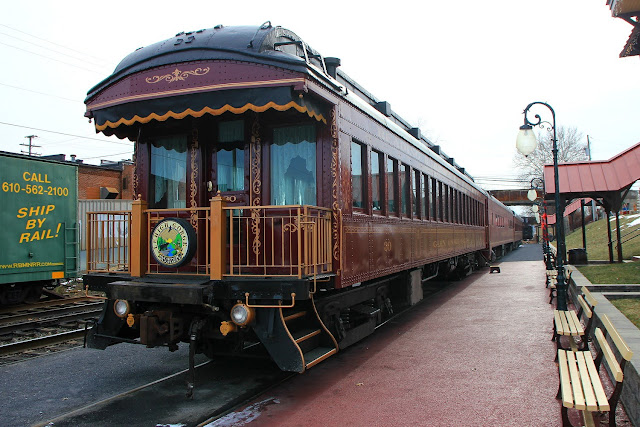The Tunkhannock Viaduct, sometimes known as the Nicholson Viaduct or Nicholson Bridge due to the community it spans, is typically viewed as a singular achievement of railroad engineering. In actuality it was just the showpiece of a far larger project initiated by the Delaware, Lackawanna and Western Railroad in 1915. The Clark's Summit-Hallstead Cutoff (aka the Pennsylvania Cutoff or Nicholson Cutoff) was the second great construction project undertaken by the DL&W shortly before The Great War (the first being the famous Slateford cutoff in New Jersey that proceeded the PA cutoff by a few years) and replaced over 40 miles of the 1850's era alignment with a brand new, high speed and low grade main line. The viaduct, measuring 2,375 feet in length and 240 feet above the ground at its highest point, was necessary to traverse the Tunkhannock Creek at an elevation sufficient to free the railroad from having to follow the path of existing rivers just north of Scranton.
Fueled by the flush profits transporting premium home heating coal at the turn of the century, the DL&W had the financial resources to not only reconstruct its greater Pocono region main lines, but also use the era's high tech wonder material, reinforced concrete. It would be the bridge's 167,000 cubic yards of concrete that would make it such an iconic and imposing presence compared to a similar bridge of steel beams.
The bridge consists of 10 spans, 9 piers and 2 abutments, all made from reinforced concrete. At the time of construction it was the largest concrete structure in the world and is likely still one of the largest concrete bridges in the world.
Although still branded Lackawanna, the DL&W Main Line did not survive the 1960 Erie Lackawanna merger with most traffic transferring to the Erie side. The Conrail merger of 1976 saw the line pass to the Delaware and Hudson, which was able to abandon its own less efficient Scranton-Binghampton route. In the 90's the D&H was sold to Canadian Pacific before ultimately falling under the umbrella of Norfolk Southern in the 2014.
The scope of the cutoff can be seen at other points along the line where local roads have to literally tunnel through the massive embankments.
The DL&W applied its use of reinforced concrete technology to everything, including station buildings and interlocking towers. Here the station in Glenburn, PA has been repurposes as public works offices with EL caboose #C267 on display nearby.
Moving down to North Reading the next morning, Kevin and I encountered the NRFF lashup awaiting its departure with GP38-2 #2014 on the tail end behind the two NRFF painted SD50s.
MP15DC's #1540 and #1541 were busy in the yard making up the train.
At the North Reading passenger station a set with an observation car on each end, RBMN #30 and RBMN #1, and no locomotive was an interesting take on luxury railroading.
Kevin also pointed out a former VIA sleeping car, recently purchased by the R&N, that was still equipped for steam heat!
The Colebrookdale Railroad runs on the former Reading Colebrookdale Branch that runs north from the former Reading Main Line in Pottstown, PA. The branch was cast off by Conrail and has been in and out of public ownership since 1983. Currently owned by the county and operated by the Colebrookdale Railroad, that has been running a robust tourist and freight operation since 2014.
The service has proven so successful that the CRR has purchased two locomotives for a steam programme, however today most of the work is carried out by Southern Railway high hood GP38-2 #5128.
The railroad also got a $25 million grant to improve the entire 9 mile branch and restore service to a quarry north of where the tracks currently terminate past the Boyerstown station platform where doodlebug railcar #M-55 was parked during my visit.
The passenger trainsets appear to be Edwardian, but are actually modified 1920's heavyweight equipment.
After thanking Kevin for his time, I headed back to Philly via the I-76 corridor where I happened to spot N&W heritage unit #8103 hiding out just east of the Manayunk Bridge.
This brings my 2022 Scranton road trip to and end. Next week I'll be back on the road again to check out Boston's trolleybus network before its demise.























No comments:
Post a Comment